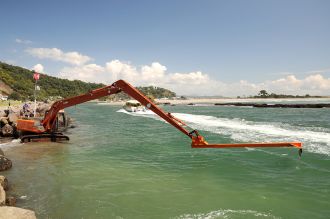 A new land-based dredging approach being trialled at the Whakatāne River entrance is providing promising results, with significant improvements in channel depth achieved in the last week.
A new land-based dredging approach being trialled at the Whakatāne River entrance is providing promising results, with significant improvements in channel depth achieved in the last week.
The trial involves the use of a six-metre extension boom and blade, developed collaboratively by Robinson Earthmovers and Whakatāne District Council staff. The extension boom allows the company’s long reach digger to extend further into the navigable channel and is used to drag sand and silt into the base of the eastern training wall. Conventional bucket excavation is then used to remove the sand from the channel.
Soundings undertaken on Wednesday confirm that the low tide depth through the Narrows and outer channel area had increased by up to one metre in some locations. The depth at the river bar remains steady at 1.2 metres, despite a prolonged period of relatively low river flows.
Whakatāne District Council Business Services Manager Roslyn Mortimer says staff are optimistic that the new dredging method will provide a workable solution to the recurring siltation issues at the harbour entrance.
“For the past week, the digger has been scraping and excavating on alternate days along the outer training wall, and that work has made a noticeable difference, with the low tide depth increasing from less than 1.5 metres to between 2 and 2.6 metres,” she says. “In the context of what we’ve been able to achieve previously, that’s a very significant gain.”
The Council also has earthmoving equipment working on the western side of ‘Statue Rock’, lowering the height of the spit to provide a ‘floodway’. When the river is in flood, this allows part of the flow to spill between the rock and the spit, reducing the possibility of flooding issues upstream.